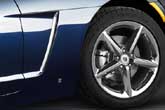Recent Articles
Popular Makes
Body Types
2007 Saturn Sky Red Line First Drive
GM unleashes a half-price Corvette

Saturn Sky Red Line – First Drive: Buying a new Chevrolet Corvette Convertible requires almost $53,000, a sum that delivers a world-class sports car with stunning performance. If your budget can't handle the Corvette, we recommend trying a Saturn Sky Red Line, which costs almost half that figure at $27,895 and puts an impressive sports car with entertaining performance in the driveway. No, it won't keep up with the Corvette and isn't quite as sophisticated in terms of engineering or execution, but in most respects driving a Sky Red Line is similar to Chevy's hot roadster, and the Saturn looks just as good as its corporate General Motors cousin. No, we aren't smoking the public relations pipe. The reason the Sky Red Line does a fair impression of a Corvette is because it's been infused with a 260-horsepower turbocharged and direct fuel-injected four-cylinder engine that can propel the two-seater from zero to 60 mph in 5.5 seconds. Combine the thrust and speed of the blown four with a view over a hood that mimics the topography of the Corvette, and all the Saturn is missing is the rumble of an all-American V8. In addition to the huge injection of power and performance, the 2007 Saturn Sky Red Line gets black headlamps bezels, dual exhaust outlets, polished aluminum wheels wearing Eagle F1 performance tires, a sport-tuned suspension, a limited-slip differential, functional brake cooling vents, and StabiliTrak stability control. Inside, the Red Line receives specific embroidery on the seats and floor mats, a leather-wrapped steering wheel with stereo controls, stainless steel scuff plates, stainless steel pedal covers, unique gauges, and a digital turbo boost gauge in the Driver Information Center. Otherwise, the Red Line is identical to standard Skys, which come well equipped with power windows, power door locks, power mirrors, remote keyless entry, cruise control, a tilt steering wheel, air conditioning, and a stereo with a CD and MP3 player. The Red Line's options list is limited to leather upholstery ($475), an automatic transmission ($850), a decklid spoiler that looks totally out of place ($275), Monsoon sound system ($590), a six-disc CD changer ($300), XM satellite radio ($199), chrome wheels ($545), and a garish paint color called Sunburst Yellow ($195). Saturn invited us to Santa Barbara's wine country for a day of driving great Central California roads in the new Sky Red Line, and the roadster proved itself worthy against its closest competitors, the Honda S2000 and Mazda MX-5. The only downside is that, like a Corvette stacked up against a BMW Z4 M Roadster, the Sky Red Line relies on its brawn and appealing design to make up for a lack of finesse and refinement in comparison to the Honda and Mazda.
Nuts and Bolts
Nuts and Bolts The Saturn Sky Red Line's turbocharged engine makes its peak torque between 2,000 and 5,000 rpm, meaning that acceleration from a wide variety of speeds is instantaneous and that the engine feels like its never gonna quit when running hard. At the heart of the 2007 Saturn Sky Red Line is an aluminum 2.0-liter Ecotec inline four-cylinder engine equipped with continuously variable valve timing, aluminum pistons with oil-jet cooling, a forged steel crankshaft, direct fuel injection, and a twin-scroll turbocharger to make 260 lag-free horsepower at 5,300 rpm and 260 lb.-ft. of torque peaking between 2,000 rpm and 5,000 rpm. These specifications mean that this is the highest specific-output engine that General Motors has ever created. This is also the first direct-injection engine GM has ever built, with power, efficiency and lower emissions the main benefits of such technology. Our real-world fuel economy averaged 22.3 mpg, better than we recorded in a standard 177-horsepower Saturn Sky without benefit of direct injection or a turbocharger, and at the low end of the EPA's 22 city and 31 highway estimate. Clearly, this is one of the most sophisticated engines in the GM stable – who knew the Ecotec had such tremendous potential? The Sky Red Line comes standard with a five-speed manual transmission and a limited-slip rear differential, with a five-speed automatic available as an option. The Aisin-sourced manual's roots are in the Chevrolet Colorado and GMC Canyon pickups, and when launched in the 2006 Pontiac Solstice this transmission was a clunky, noisy gearbox. GM modified it for 2007, adding a torque tube which puts the mechanicals further back in the car and gives the setup a much-needed dose of refinement. The Sky Red Line's clutch is also beefier than stock, and while the combination still cannot match a Honda S2000 or Mazda MX-5 in terms of shifting pleasure, it's far removed from its pickup truck origins. Most Saturn Sky Red Lines are probably going to be sold with the optional Hydra-matic five-speed automatic, given that most Americans can't or won't shift for themselves. This makes a fine choice, however, with a single exception. Saturn doesn't supply a way to manually shift gears with this transmission. By contrast, the Mazda MX-5 is available with a slick-shifting six-speed automatic with paddle shifters, while the Honda eschews an automatic altogether to ensure that only true enthusiasts buy an S2000. Riding on a four-wheel independent short- and long-arm suspension, the Sky Red Line is equipped with thicker front and rear stabilizer bars, as well as specific springs. Wheels are 18 inches in diameter, just like the regular Sky, in the Red Line's case polished rather than painted and mounted with more aggressive Goodyear Eagle F1 GS2 tires sized 245/45. Crank the hydraulic rack-and-pinion steering around a skidpad, and Saturn says the Red Line will push .90g. Four-wheel-disc antilock brakes deliver short stopping distances, and if the driver exceeds the level of grip provided by the Eagle F1 tires, StabiliTrak stability control is standard to help keep the Sky's rubber on the road.
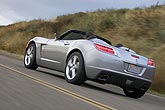
Design
Design Not only does the 2007 Saturn Sky Red Line possess Corvette Jr. performance, it resembles the iconic Chevrolet sports car. However, the Saturn is more of an exercise in form over function than the Corvette. It doesn't take a doctorate degree in geothermal physics to figure out that design is the Saturn Sky's main selling point. Just look at it. The Sky strongly resembles the more expensive Corvette right up to the rear wheels, where it takes on a character of its own through frosted horizontal taillight lenses, outboard rectangular exhaust outlets, a cool central reverse light, and those sexy headrest fairings that force the car's major flaw: the design of the convertible top. To preserve those headrest fairings, the Sky needed to have a hard tonneau cover. To have a hard tonneau cover, the Sky's rear decklid is reverse-opening affair. Because the Sky's rear decklid is a reverse-opening affair, it is a bigger hassle to lower and raise the roof – not to mention load cargo into the small trunk. The result is a roadster that requires far more effort than the Honda and Mazda to open when warm sunny days beckon or button up when warm summer showers arrive. The Saturn Sky's interior, too, is an example of form over function, featuring stylish piano-black plastic trim and chrome accents, but suffering a dearth of storage space and compromised control placement. The chrome around the gauges throws glare in bright sunlight, the stereo display is impossible to read with the top down on sunny days, and there's no passenger's side vanity mirror for your Significant Other to use after a top-down drive to dinner. Furthermore, there's no power door lock button anywhere inside the Sky, and the cupholder that pops out of the passenger's side of the center console constantly deploys when the passenger's knee presses against it while running hard on a twisty road. Finally, have fun contorting your wrist to use the power window controls. Though its competition from Honda and Mazda employs top-notch interior materials, the Saturn takes the usual General Motors path of cost-cutting in an effort to maximize per-unit profit. The dash materials are hard, unyielding, and glossy, and our test sample displayed several fit-and-finish issues, such as the rough plastic edges on the glovebox door and the loose fit of the center console panel. We did like the contrasting red leather upholstery in our loaded Red Line, which looked especially fetching with the silver metallic exterior paint job.
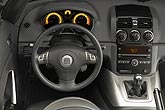
Comfort
Comfort Comfort is elusive in the Saturn Sky Red Line, but that's true of the car's competition as well. Still, the car feels two sizes too big from the driver's seat, and the climate system is ill-equipped to deal with hot days and chilly nights. Two-seat roadsters are not known to be comfortable. Usually, their interiors are small, confining spaces with a high claustrophobia factor when the roof is raised. Add a stiff ride quality to the mix, and it's not surprising that most of these sports cars are bought by driving enthusiasts and not daily commuters. The 2007 Saturn Sky Red Line is no different. Because of its unique control placement, the driving position in the Sky feels a little taller than its corporate sibling, the Pontiac Solstice. Still, occupants sit low in the Sky, the beltline is tall, and the net effect is not unlike when you goofed off behind the wheel of your father's car while it sat in the driveway, your ten-year-old body not quite able to see over the steering wheel and reach the pedals at the same time. It doesn't help that the gearshift and parking brake are located so high on the central tunnel. The result is that the Sky feels a couple of sizes too big even though its bolstered bucket seats are hugging tight. By contrast, a Honda S2000 or Mazda MX-5 provide a more tailored feel and fit. The Sky's seats are quite comfortable however, and there's plenty of leg room even for a taller driver or passenger. Cabin turbulence is significant with the windows down, and not much better with the side glass raised. It doesn't help that the Sky's air conditioning has trouble keeping the cabin cool on hot days, and there aren't any seat heaters to provide added comfort on chilly evenings. Finally, we have an issue with the design of the Sky Red Line's leather-wrapped but thinly padded steering wheel, which tilts but does not telescope. After two days of driving, the sharp radius on the front of the steering wheel rim had bruised my palms, causing bolts of pain when too much pressure was applied to the sensitive spots.
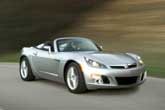
Driving Impressions
Driving Impressions The Saturn Sky Red Line's impressive engine is the best part of the driving experience, but the handling provides miles of smiles, too. We'd like to see brake pedal and road feel improvements. Our test drive of the 2007 Saturn Sky Red Line led from the coast in Santa Barbara, up highway 101, then along the back roads of the Santa Inez Valley, famous for its wine, its scenery, and Michael Jackson's Neverland Ranch. On this route we were able to sample the car in a city environment, on the expressway, and on the twisty two-lane roads where the Sky Red Line is most at home. In most respects, we decided that the Sky Red Line is a capable, engaging, and entertaining sports car. Let's get the criticism about the driving the car out of the way. The brake pedal feels too stiff, features a limited range of travel, and makes it hard to feed fine-tuned pressure to the discs. Also, if you choose the automatic transmission, you may be dismayed by the lack of a manual shifting mode. Otherwise, the Saturn Sky Red Line is one fun car to drive. Finally, the steering isn't as communicative as we might like, but we like what a BMW delivers and few vehicles on the road today manage to match the best from Bavaria. Though the Sky Red Line's manual transmission could use added refinement and an extra gear, it's a much better piece of engineering than what we've experienced in the 2006 Pontiac Solstice. The addition of a torque tube gives the shift action more refinement and better feel while placing the mechanicals farther back in the chassis to improve isolation from the cabin. No, it's not on par with the industry-defining manual gearboxes installed in the Honda S2000 or Mazda MX-5, but if you've never driven one of those two sports cars, you won't know the difference. Though we claim that road feel could be better, the steering is sharp and responsive, guiding the sticky 18-inch Goodyears around turns with precision. The suspension is taut but compliant enough that the driver and passenger can emerge from a day in the car without fused vertebrae. Body roll is virtually non-existent, and it takes some serious speed or a bone-headed move to break the tires loose, which means the Saturn is not quite as tossable in the hands of an experienced driver as the Honda or Mazda. But since most drivers aren't “experienced,” this is a good thing. StabiliTrak and OnStar are aboard to save the day or rescue your butt if the Sky does get too far out of shape. The best thing about driving the Saturn Sky Red Line, however, is the engine. The twin-scroll turbocharger spins up quick, cutting lag times. And with torque peaking way down low at 2,000 rpm and stretching across the powerband to where maximum horsepower is made, the Sky Red Line feels like a rocket. The car just wants to go, go, go – and doesn't force a downshift or two to take advantage of passing opportunities or holes in traffic the way its key competitors do. The Mazda MX-5's measly 170 horsepower is no match for this car, and the high-revving 237-horsepower Honda S2000 is going to work much harder to generate the same kind of speed. Our clear preference is this turbocharged four-cylinder from GM, and when you consider that we averaged 22.3 mpg despite regular dips into the Ecotec's reserve of power, it's an even more impressive piece of work.
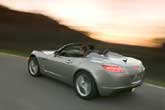
Specifications
Specifications The 2007 Saturn Sky Red Line's primary competitors are the Honda S2000 and Mazda MX-5. Test Vehicle: 2007 Saturn Sky Red Line Price of Test Vehicle: $29,159 (manual model, including $600 destination charge) Engine Size and Type: 2.0-liter turbocharged inline four cylinder with direct injection and variable valve timing Engine Horsepower: 260 at 5,300 rpm Engine Torque: 260 between 2,000 and 5,000 rpm Transmission: Five-speed manual; Five-speed automatic Curb weight, lbs.: 2,990 (manual); 3,024 (automatic) EPA Fuel Economy (city/highway): 22/31 mpg (manual); 21/29 mpg (automatic) Observed Fuel Economy: 22.3 mpg (manual); 21.7 (automatic) Length: 161.1 inches Width: 71.4 inches Wheelbase: 95.1 inches Height: 50.1 inches Leg room: 42.7 inches Head room: 38.4 inches Max. Seating Capacity: Two Max. Cargo Volume: 5.4 cu.-ft. (top up); 2.0 cu.-ft. (top down) Competitors: Audi TT Roadster, BMW Z4, Chrysler Crossfire Convertible, Honda S2000, Mazda MX-5, MINI Cooper Convertible, Nissan 350Z Convertible
Photos courtesy of Saturn
